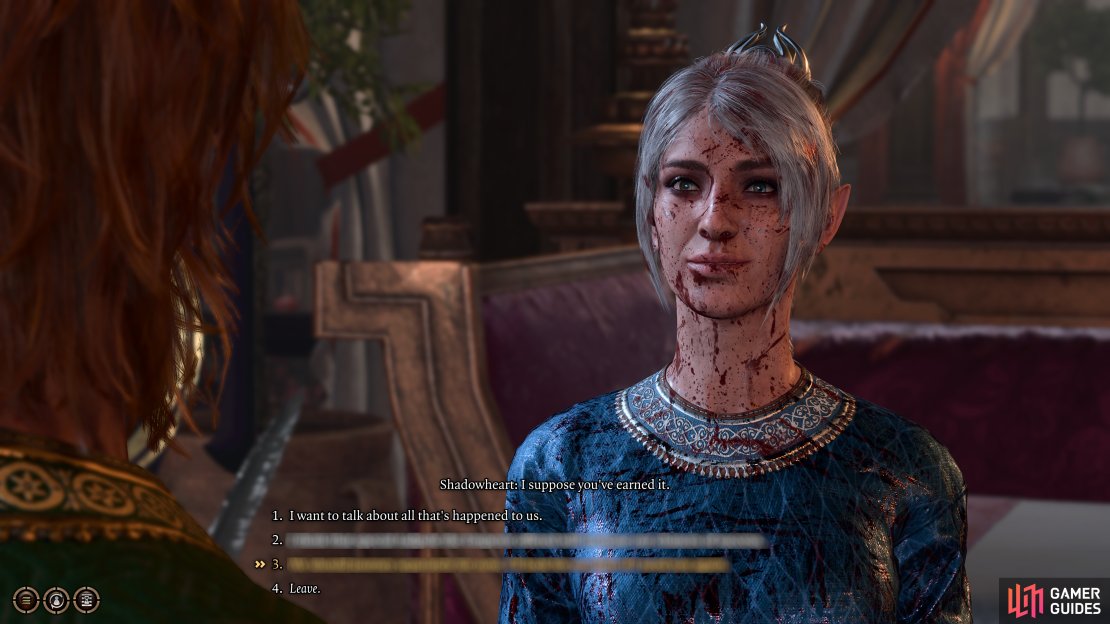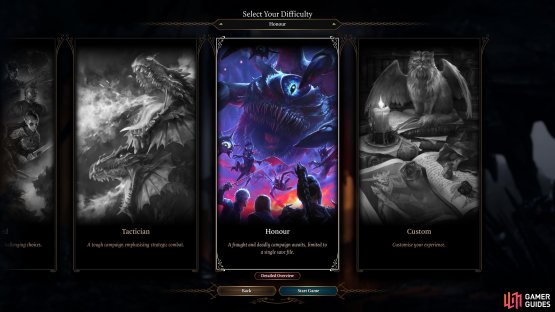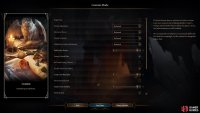If you thought you were truly deserving of the Crown of Karsus for completing Baldur’s Gate 3 on Tactician mode, think again. Larian Studios has introduced two new difficulty settings with Patch #5, namely Honour mode and a Custom mode. The Honour difficulty setting doesn’t actually require you to be honorable; you can still indulge in the most sinister impulses as the Dark Urge. Instead, what it really brings is a new level of the hardest difficulty for the game, going above and beyond Tactician with stronger bosses, stricter rules, and a limit of one save file. The Custom mode, on the other hand, is exactly what it suggests: you’ll be able to tweak a number of difficulty settings in a way that suits your playstyle best, whether by making some elements of the game more difficult, and others easier, you can customize your own unique difficulty level. On this page, we’ll explain all the changes that these two new settings introduce and show you how to use them.
You can expect things to get even bloodier than Shadowheart here with the new Honour mode in Baldur’s Gate 3.
What Is Honour Mode in Baldur’s Gate 3?¶
As briefly mentioned above, the new Honour mode for BG3 is the most brutal difficulty setting available for the game. Larian sums it up with the phrase “A fraught and deadly campaign awaits, limited to a single save file.”, but this tells only part of the story. A more detailed look at the settings reveals exactly how the game is made more difficult in this mode.
The first thing you should note about Honour mode is that it’s not intended for new players. You’ll want to be familiar with the basic mechanics of the game before you throw yourself into a campaign on this difficulty setting, especially since you can clumsily die by misadventure if you’re not familiar with how running and jumping works. It’s all too easy to die by wandering into a toxic fume or falling off the edge of a cliff. With only one save file allowed in Honour mode, you don’t want this to be the way you end the adventure.
Can You Change Custom Difficulty Settings for an Existing Save?¶
It’s worth noting that you won’t be able to change your difficulty setting to the Honour or Custom modes for an existing playthrough. You can only do this at the start of a new campaign. The only exception is for those who have failed the Honour mode, at which point you’ll be presented with a screen to change the difficulty settings as you would for a Custom mode at the beginning of a game. You won’t be able to keep playing in Honour mode from this point, though.
Stronger Bosses - New Abilities and Legendary Actions¶
Another reason why you might want to play the easier difficulty settings first (either Explorer, Balanced, or Tactician) is that some of the strongest bosses in the game have new abilities and Legendary Actions in Honour mode. If you want to fully appreciate just how much more difficult they’ve become, it helps to have an idea of how difficult they were in their base forms first. There will always be more health on bosses and higher damage attacks from them in Tactician mode compared with Balanced, but they’ll still have the same arsenal of attacks to draw from.
The new abilities and legendary actions that come with Honour mode for some of the most powerful bosses not only make the game more challenging, but it can also help to keep things interesting and refreshing if you’re fighting them on your gazillionth playthrough. You can expect to experience more of that novel sense of “what the hell is going to happen next…” when facing the scariest foes!
Stricter Rules - Tactician vs Honour¶
The other main mechanic where you’ll see a noticeable increase in difficulty for Honour mode is with stricter rules for things like actions and damage bonuses. You can expect to have fewer actions to work with for each player, and you won’t be able to achieve the same level of damage bonuses by combining the effects of potions and spells. In other words, you can say goodbye to the excessive AP bonuses that experienced fighters such as ![]() Lae’zel rely on to take out multiple foes in one round. This was implemented to some degree with the already tough Tactician difficulty, but it’s even more harsh in Honour mode.
Lae’zel rely on to take out multiple foes in one round. This was implemented to some degree with the already tough Tactician difficulty, but it’s even more harsh in Honour mode.
(1 of 2) You can only choose Honour mode at the beginning of a campaign, and there’s no way back until death.
You can only choose Honour mode at the beginning of a campaign, and there’s no way back until death. (left), You can curate your own custom difficulty setting using the new custom difficulty mode at the beginning of a game. (right)
The main implication here is that you’ll need to be far more careful with your tactical decisions when fighting large groups of enemies, but also when fighting some of the toughest bosses. You’ll need to consider your positioning after going in for a hit by trying to use aspects of the environment to gain cover, especially if you’re on the squishy side of a build. You’ll also want to make sure that every action taken is being used to its full capacity, which will require a good understanding of how different spells and potions can enhance the power of specific attacks.
Single Save File¶
Aside from all the new difficulty changes noted above, the main thing that makes the Honour mode so brutally unforgiving is the limitation to a single save file. This means that you won’t be able to reload older saves if things don’t go the way you planned. If you lose a companion, they’re gone for good. If you fail to achieve the desired outcome for a specific quest, there’s no turning back. And, most ruthlessly, if your entire party dies, it’s game over.
The one saving grace that comes from Honour mode is that if you do happen to die and there’s no way back for your party, it’s not necessarily the end of the road. You can still continue that specific playthrough by selecting new custom difficulty settings, but you’ll no longer be playing in Honour mode. This means that you won’t earn any achievements related to it, and you’ll miss out on the opportunity to fight bosses with their new abilities and legendary actions.
In short, Honour mode is the most brutal difficulty setting you can experience in Baldur’s Gate 3, and it has the potential to ruin your day if things don’t go as planned. You don’t need me to tell you how tragic it would be to have played 40+ hours of a campaign in Honour mode, only to die in the most devastating circumstances. It’s a high-risk, high-reward way of playing the game, and you know that everything will feel more intense with the knowledge that there’s no way back from the brink!
As for me, I’ll be trying Honour mode with a party of friends. I don’t trust myself to make the right decisions to get through it alone, and I’ll need some shoulders to lean on as we wallow in our collective misery when the inevitable happens.
How Does Custom Mode Work in BG3?¶
If the above has scared you into submission and you’d rather not think about the depths of sadness that you’re likely to experience after failing in an Honour mode campaign, there’s still hope with the Custom mode settings. These will allow you to change a host of things that were previously set to specific levels for the basic Explorer, Balanced, and Tactician difficulty modes. We’ve provided a table below which explains what each of the individual settings does for your convenience.
All Custom Mode Difficulty Settings Explained¶
The stated effects for each difficulty setting are described mostly in the same way as they are in-game. However, we’ve added a few words here and there to clarify their meaning. Note that the first four settings after “Single Save” are defined by the default difficulty levels of Explorer, Balanced, and Tactician.
| Setting | Effects |
|---|---|
| Single Save | You will only have a single save slot. The setting can’t be changed once the game starts. |
| Enemy Aggression | Adjust how dangerous enemy combatants will be in combat. |
| Character Power | Adjust how powerful players, allies, and enemies are by modifying their bonuses to rolls and how hard they are to kill. |
| Enemy Loadouts | Adjust the items and spells enemies will have access to in combat. |
| Additional Combat Mechanics | Change the difficulty of combat scenarios by adjusting how many new mechanics or enemies are added to certain fights. |
| Proficiency Bonus | Increase the proficiency bonus of all characters - reducing the impact of random rolls (from -1 to +4). This will impact game balance. |
| Enemy Critical Hits | Enemies will be able to score Critical Hits by default. Untick the box to disable. |
| No Death Saving Throws | Enable to stop player characters dying at 0 hit points. They will be stabilized until Helped. |
| Disable Free First Strikes | Harming a character before combat starts will cost you one attack or action on your first turn in initiative by default. Disable to keep the attack or action instead. |
| Camp Cost Multiplier | Adjust how many camp supplies a Long Rest costs (from 0.5 to 3). |
| Short Rest Full Heal | Enable to fully restore party health on a Short Rest. |
| Trader Price Modifier | All prices traders ask for their wares are multiplied by this value. All prices you get for your gear are divided by this value (from 1 to 4). |
| Multiclassing | Enable to allow choosing an additional class upon level-up. This setting can’t be changed once the game starts. |
| Always Prompt Reactions | All reactions that can pause the game will do so by default. |
| Hide NPC Health | Only HP counts of characters controlled by players will be displayed. |
| Hide Failed Perception Rolls | Perception rolls to spot traps and hidden objects in the world will only be displayed if successful. |
| Hide Passive Rolls in Dialogues | Prevent dialogues showing you if you have passed or failed a passive roll to learn information. |
| Preview Dialogue Check Difficulty Before Rolling | Enable to see how hard Ability or Skill Checks will be before you select them as dialogue options. |
| Hide Difficulty Class During Rolls | Obscure the Difficulty Class while making Ability or Skill Checks during dialogues, lockpicking, and disarming traps. |
Foehammer Achievement for Honour Mode in BG3¶
That should tell you all you need to know about the Honour and Custom difficulty modes and their specific settings in Baldur’s Gate 3. All that remains is to mention the new Foehammer achievement, which you can only get after completing the entire campaign in Honour Mode. Good luck with that…





No Comments